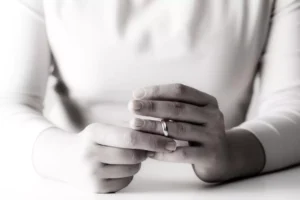I had a good thing going during the summer of 1996. I was halfway through earning a master’s degree in public policy. During that year I formed a special bond with one of my classmates, Candice Zouhary. Besides sharing several classes, we also worked together as editors of an online magazine. Eventually, we started spending nearly all our free time together. We went to the beach, out to eat, to jazz festivals, to historic Williamsburg and to numerous coffee bars.
We could talk for hours about culture, faith, generational issues, Internet journalism and many other shared passions. Even though we were different in substantial ways, we found much common ground.
At 26, I knew I was running a little late on the marriage timeline I set for myself, but frankly, I wasn’t in any hurry. I had a safe and comfortable friendship with Candice. I liked what we had going. As summer started winding down, however, Candice did something unusual — she interrupted our good thing.
Telling me that she wanted more in our relationship, she must have known she was threatening a good thing. What I didn’t see in the moment, however, was how her challenge would put an end to three of my worst relational habits — problems which (I’ve discovered) threatened other “good” relationships as well.
The Buddy Approach
The first habit Candice challenged was my casual approach to relationships. It was innocent enough, I thought — an insurance policy of sorts I had developed a few years before.
It started back in college when I pursued a girl I liked. I frequently wrote about her in a journal. One night I got up the nerve to share with her what I had written. After reading the last passionate phrase aloud, I held my breath and looked up for a response. She didn’t look elated — in fact, she looked constipated. I knew I was in trouble when she started clarifying our relationship. When she pulled out the “just friends” phrase I was too embarrassed to keep going.
I vowed I would learn from that failure. Over the next few days, I crafted what I thought was an ingenious approach to women: the “buddy approach.”
In the movie When Harry Met Sally, Harry declared that men and women can’t be just friends — I set out to prove they could. I saw it as a safe way to take a chance — to see if a relationship could grow without the pressure of formal dating and terms like “boyfriend” or “girlfriend.” If the friendship began to disappoint, I could always just say, “oh, maybe you misunderstood me, we’re just friends.”
After a year of introducing her as “my friend,” Candice wanted me to be honest about the nature of our relationship. “Is this dating or something else?” she asked. “How do you describe all the time we spend together? Is this relationship going somewhere?” I knew I needed to answer these questions — I couldn’t just leave our relationship in limbo.
My Wandering Eye
The next challenge was a little more indirect. Candice said she wanted me to define our relationship before the new school year started. She said it was important for new students to know whether she was available or not.
This was a weak spot for me. In four years of college, three years of college administration and then graduate school, I had grown to look forward to fall and the batch of new women it brought to campus.
Jerry Seinfield once said, “Guys don’t want to see what’s on television — they want to see what else is on television.” I guess that’s how I saw women. I didn’t just want to see one woman, I wanted to see what other women were available. To make matters worse, my expectations for women were set by movies and magazine covers that caused me to fantasize about perfection and to overlook the real and available women right in front of me.
I realized that honesty about the deep friendship I enjoyed with Candice meant I had to quit looking out of the corner of my eye for other options. She deserved my full attention. Traditional wedding vows often include the phrase, “forsaking all others as long as you both shall live.” I knew I needed to start practicing the art of “forsaking.”
Making a Choice
Candice didn’t issue the third challenge directly, but her comments brought it to the surface. Our talk confronted my ability to make a choice for marriage. I knew I was in a good relationship, but I needed to decide if it could become the relationship.
It took me to that crucible question every man must answer: “How do I choose the right woman among the 3 billion available on the planet?” After hearing my dad explain how God told him to go to a certain church service where he would meet his wife (he proposed only weeks later), I always assumed I would have a similar “burning bush” experience. Frankly, I was still waiting for that supernatural sign to give me the guts to commit myself to one person for the rest of my life.
Gordon Gano, leader of the 80s band the Violent Femmes, settled down enough as he got older to make a dead-on observation. In an interview with Details magazine, he explained that men by their nature overestimate their potential. Men assume they can have any woman. In their minds, commitment to one woman inevitably requires subtraction — it means limiting themselves to only one slice of a large pie.
I started to see that one slice of pie differently, however, once I decided to stop pretending Candice and I were just buddies and tried to reign in my wandering eye. It was then that I was reminded of the phrase “less is more” — how getting rid of the clutter helps the best stuff stand out.
Back when I was editor of my college yearbook, I got a crash course in photography. My photo editor told me, “don’t try to capture the whole world in one photo. Don’t feel the need to take one of those panoramic Grand Canyon like photos that attempts to squeeze everything in. Instead, focus in on something, a single building, a flower or an expressive face.”
Commitment means looking past the 3 billion other women in the world and zooming in on one person — studying her, knowing her, and learning to love her deeply while she goes through the same process with you.
Candice’s challenge forced me to get serious about the question I had been asking myself all along. “Even without burning bushes, is a good friendship fertile ground for a good marriage?” Now that Candice made it clear that I couldn’t just go on enjoying my good thing, I had to determine if that good thing could grow into something better: a lifelong commitment.
Over the next few months, I thought more seriously about our relationship. I thought about how nice it was that we knew each other well enough to finish each other’s sentences. I especially learned to value how closely aligned our passions and sense of mission were. What put me over the top was when I came to appreciate how comfortable Candice made me feel in my own skin — she knew all my good and bad and still loved me.
I could have kept waiting for the light of a burning bush, but I guess what I needed most was to have the smoke cleared away so I could see and appreciate what I had in Candice. Her challenge was difficult in the moment, but it was exactly what I needed to be honest about our relationship, to be focused on her and to be willing to make a lifelong choice.
Copyright 2003 Steve Watters. All rights reserved.











